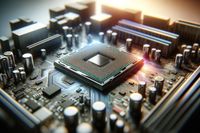The Rise of Arm in Computing: More Than Just Mobile?
The landscape of Arm-based computing unfolds, promising continued innovation and a transformative future.

Arm in PC hardware
Recent advancements in Arm-based personal computers have showcased the architecture's potential to balance performance and power efficiency. Noteworthy Windows on Arm laptops, such as Microsoft's Surface Pro X and Lenovo ThinkPad X13s, highlight Arm's capacity to meet the diverse needs of users. Despite challenges related to software compatibility, the benefits of Arm, including energy efficiency and modular scalability, position it as a compelling player in the ever-expanding landscape of personal computing.
The evolution of Arm architecture in personal computers marks a departure from its roots in mobile devices. Arm-based PCs offer notable advantages, including energy efficiency, reduced heat generation, and increased performance-per-watt compared to traditional x86 architecture. However, challenges such as software compatibility and legacy support have slowed widespread adoption.
The adaptability of Arm architecture has spurred innovation among manufacturers, leading to the development of diverse Arm-based products that cater to different market segments. As the industry navigates this shift, the advantages of Arm, particularly its efficiency and scalability, are influencing the design and development of personal computing devices. This evolution underscores the computing landscape's dynamic nature and Arm architecture's significant role in shaping its future.
Benefits of Arm over x86 architecture
The benefits of Arm over x86 architecture are multifaceted. Arm's Reduced Instruction Set Computing (RISC) architecture allows for streamlined instruction execution, improving performance and energy efficiency. The modular nature of Arm's design facilitates scalability, enabling manufacturers to tailor processors for specific use cases. Additionally, Arm's dominance in mobile devices has spurred a rich ecosystem of developers and software optimized for its architecture, contributing to enhanced user experiences on Arm-based devices. These advantages position Arm as a compelling alternative to x86 architecture across various computing applications.
Arm's architecture offers inherent advantages in power efficiency, making it well-suited for a range of devices beyond traditional computing. The architecture's scalability is particularly advantageous, allowing manufacturers to create a spectrum of devices, from energy-efficient laptops to high-performance servers. As the industry witnesses the benefits of Arm in real-world applications, the momentum behind this architecture continues to grow, challenging the long-standing dominance of x86 in the computing landscape.
Windows on Arm
Windows on Arm (WoA) is a version of the Windows operating system designed to run on devices powered by Arm-based processors, a departure from the traditional x86 architecture. This iteration promises enhanced power efficiency, longer battery life, and potentially thinner and lighter form factors compared to their x86 counterparts.
Initially introduced as Windows RT in 2012, the platform faced limitations due to software compatibility issues and a lack of native applications. However, recent advancements, notable with Windows 10 on Arm, have aimed to address these concerns by implementing emulation technology to run x86 applications seamlessly. App support continues to be the main problem in WoA, and many Arm machines are hamstrung by inferior performance that struggles with the required emulation.
The next few years of Windows on ARM (WoA) appear increasingly promising as major players like Nvidia and AMD plan to unveil ARM-based SoCs, promising to push the boundaries of performance and efficiency. Qualcomm's Snapdragon X Elite, touted as its most potent PC computing processor, signifies the company's commitment to advancing WoA-powered devices. Meanwhile, continuous efforts from Microsoft and Arm to refine emulation for non-native applications enhance the platform's compatibility and usability. With a surge in Arm-based products anticipated to intensify competition, the landscape seems ripe for innovation, potentially driving the development of more diverse and powerful WoA devices in the coming years.
Apple Silicon: Revolutionizing the Landscape
Apple's transition to Arm architecture with the introduction of the M1 chips has set a new standard in the computing industry. The M1 (and subsequent M2 and M3 generation) chips leverage Arm's architecture to deliver impressive performance gains while maintaining energy efficiency. Key features include a unified memory architecture, high-performance GPU, and hardware acceleration for machine-learning tasks. The integration of Apple Silicon chips into MacBooks and iMacs has received widespread acclaim for its seamless performance and improved battery life, reshaping user expectations and challenging the dominance of x86 processors.
Apple's homegrown Silicon chips have demonstrated the capabilities of Arm architecture and spurred a broader industry conversation about the future of computing. The success of M-powered devices has prompted other manufacturers to explore Arm-based solutions, signaling a potential shift in the competitive landscape. As Apple continues to iterate on its Arm-based offerings, the impact on hardware and software development is poised to shape the computing trajectory for years to come.
Nvidia's Deal with Arm: Shaping the Gaming Industry
Nvidia's attempted acquisition of Arm in 2020 holds significant implications for the gaming industry. Arm's energy-efficient architecture aligns with the growing demand for high-performance, efficient gaming hardware. The integration of Arm technology in gaming processors could lead to advancements in graphics capabilities and overall gaming experiences. However, concerns about potential monopolistic practices and regulatory challenges loomed over this deal, prompting scrutiny from industry experts, competitors, and regulatory bodies.
Nvidia eventually couldn't follow through with this deal and announced the termination of this project in 2022. However, the potential synergies between Nvidia's expertise in graphics and Arm's efficiency-driven architecture open up possibilities for groundbreaking developments in gaming hardware. While the deal fell through, the attempted acquisition (and subsequent failure) is a great example of the importance of Arm in potentially shaping the future of the computing industry.
Arm is More Than Just Hardware
Arm's influence extends beyond hardware to the software ecosystem. The architecture's impact on software development is evident in the growing support and optimization for Arm-based systems. While challenges related to software compatibility persist, developers are increasingly adapting their applications to harness the benefits of Arm architecture. Emerging optimizations, such as Apple's Rosetta 2 translation layer, aim to bridge the gap, providing users with a smoother transition to Arm-based platforms. The collaborative efforts of developers and manufacturers are essential in ensuring a robust software ecosystem for the expanding Arm architecture.
As the software ecosystem for Arm architecture matures, the collaboration between developers and hardware manufacturers becomes increasingly pivotal. The adaptability of Arm architecture allows for innovation in software design, optimizing applications for improved performance and efficiency. The cross-industry collaboration, driven by the growing adoption of Arm-based devices, underscores the importance of a cohesive software ecosystem.
Future Potential
Despite failing to secure Arm as a whole, Nvidia has not backed away from Arm computing entirely. According to recent reports, Nvidia and AMD plan to launch Arm-based SoCs as early as 2025. Qualcomm's agreement with Microsoft is also ending in 2024, which opens up opportunities for AMD and Intel to make further forays into this market.
Amidst all the upstarts in the Arm computing race, Qualcomm continues to lead from the front by announcing its most powerful computing processor ever created for PC, the Snapdragon X Elite. Designed for high-end computing with a focus on AI integration, the Snapdragon X Elite is expected to outperform the x86 competition in raw CPU performance while matching the competition with only one-third of the power consumption, according to company claims. The Snapdragon X Elite chip is expected to be integrated into OEM systems starting around mid-2024.
The rise of Arm in computing has evolved beyond its initial stronghold in mobile devices, transforming the landscape of personal computing. Arm's advantages, including energy efficiency and scalability, have paved the way for its integration into a diverse array of devices, challenging the long-standing dominance of x86 architecture. The commitment of tech juggernauts like Apple, Nvidia, AMD, Intel, and Qualcomm underscores Arm's pivotal role in shaping the future of computing and gaming.



